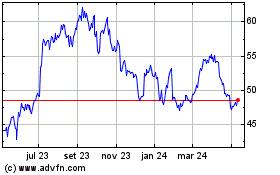BP:Mud Pumping Temporarily Halted, Studying 'Top Kill' Effect
27 Maio 2010 - 8:36PM
Dow Jones News
BP Plc (BP) said Thursday that it had temporarily stopped
pumping heavy drilling fluids into a gushing oil well in the Gulf
of Mexico as it studied the effect of the "top kill" operation and
restocked vessels containing the blocking material.
BP Chief Operating Officer Doug Suttles said that the company
had stopped pumping mud around 11 p.m. Wednesday in order to assess
the results of the first phase of the top kill and monitor pressure
in the well.
Suttles said the mud pumping would resume later Thursday
evening. He added that the operation would continue for at least
another day.
"The operation has not yet achieved its objective," he said, in
that oil was continuing to flow to the surface. "We've successfully
pumped some mud into the well bore; clearly we need to pump more
in."
The company temporarily stopped the flow of hydrocarbons while
it was pumping drilling mud at high pressure Wednesday, but
pressure from the well pushed back out into the ocean a combination
of oil, gas and drilling fluid when the pumping stopped.
The company did two rounds of pumping Wednesday evening; Suttles
said that nothing in the operation has "gone wrong" or behaved
unexpectedly.
Suttles said that BP would deploy a "junk shot," a procedure
that involves injecting material such as rubber tires and golf
balls to clog up a valve atop the well, making sure the drilling
mud is sent down the well bore.
Video transmitted live from the sea floor by BP showed a large
amount of material being ejected from a broken piece of equipment
into the ocean. Suttles said that "it's very, very difficult to
interpret" the meaning of that flow.
Suttles' comments, made at a press conference in Robert, La.,
followed remarks by Adm. Thad Allen, the leader of the federal
response effort to the spill, who said earlier that the flow of oil
had been stopped by the top kill operation. Federal authorities,
the public and the oil industry are closely watching the progress
of the operation, which could bring the massive spill to a close.
The spill began more than a month ago when a rig drilling for BP
exploded and sank.
On Thursday a team of U.S. scientists unveiled new estimates for
the amount of hydrocarbons leaking into the Gulf that showed that
the spill is at least as big as the 1989 Exxon Valdez oil spill and
perhaps much larger. That makes it the worst oil spill in U.S.
history. Criticism of the company and the federal government's
handling of the crisis ran high Thursday, as oil lapped up along
Louisiana's coastline. Also Thursday, President Barack Obama
extended a moratorium on new drilling permits and ordered the
halting of exploratory drilling in 33 U.S. Gulf of Mexico
leases.
At the news conference, U.S. Coast Guard Rear Adm. Mary Landry
said that about 101 miles of Louisiana shore were affected by the
oil spill.
-By Angel Gonzalez, Dow Jones Newswires;
713-547-9214;angel.gonzalez@dowjones.com
-0-
Schlumberger (NYSE:SLB)
Gráfico Histórico do Ativo
De Jun 2024 até Jul 2024

Schlumberger (NYSE:SLB)
Gráfico Histórico do Ativo
De Jul 2023 até Jul 2024
